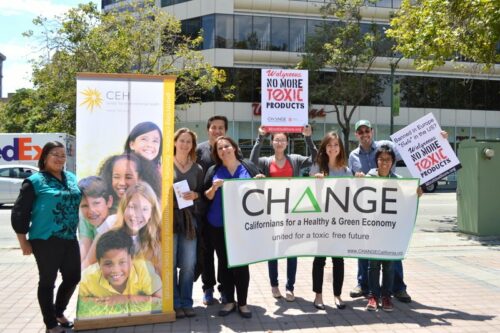
Environmental Justice Communities have suffered the consequences of incompatible land uses for decades. “Communities are not simply groupings” but that they are “families, neighbors, and individuals, who recognize the necessity of sharing responsibility. Environmental racism as “the exploitation of workers as well as the environment, the oppression of people on the basis of race, gender, sexual orientation and class.” Fair treatment implies that no population should be forced to shoulder a disproportionate share of exposure to the negative effects of pollution due to lack of political or economic strength.
CHANGE aims to serve all Californians by reducing their exposures to chemicals that can impact their health. We educate and organize communities across the state to advance and improve the enforcement of health-protective laws and regulations, and to expand the California economy through the growth of innovative green chemistry-based jobs and industries. We promote the principles established in the Louisville Charter for Safer Chemicals and striving to create a broad, multi-cultural, multi-sectorial movement to improve the health
status and environment for California’s diverse communities.
Additionally, our principles and work is guided by the Louisville Charter reform platform and guide to create safer and healthier environments through innovation. According to the Louisville Charter, a fundamental reform to current chemical laws is necessary to protect children, workers, communities, and the environment. It should be a priority for government legislation and regulatory agencies actions to protect communities health by phasing out the most dangerous chemicals, developing safer alternatives, protecting frontline communities, and ensuring that those responsible for creating hazardous chemicals and negatively impacting the health of sensitive populations are held accountable. The design and development of new, safer chemicals, products, and production systems can ensure the protection of communities’ health while creating a solidarity economy based on healthy and sustainable jobs.
The following are key steps in developing safer alternatives that could eliminate toxics’ exposure in environmental justice communities and create safe new jobs, ensuring a just transition for all, by using clean and innovative technologies:
-
Require Safer Substitutes and Solutions
-
Phase Out Persistent, Bioaccumulative, or Highly Toxic Chemicals
-
Give the Public and Workers the Full Right-to-Know and Participate
-
Act on Early Warnings and Signs of Potential Harm to Health
-
Require Comprehensive Safety Data for All Chemicals
-
Take Immediate Action to Protect Communities and Workers
In California, the most vulnerable communities are low-wage, often immigrant women of reproductive age working with toxic chemicals on a daily basis and living in communities already bearing a disproportionate burden of exposure to toxic chemicals.
CHANGE looks at the problem of exposure to unregulated chemicals in a holistic manner- from extraction of
base materials, through the production, distribution, use, and disposal of products containing toxic chemicals. Low-income communities are impacted at every stage of this life-cycle of toxic product production. Not only can toxic chemical exposure have acute negative health outcomes, but can lead to often more serious chronic outcomes such as learning disabilities or impact social behavior.
CHANGE’s strategy is to build both the knowledge of the broken system to manage and test chemicals for safety and a diverse, cross-sectional movement of allies working along this life-cycle to confront the problem. Social justice and civic engagement are strong currents throughout our work which is why we believe that the cross sector nature of our work will yield the strongest results for people disproportionately impacted by unregulated toxic chemicals exposure.